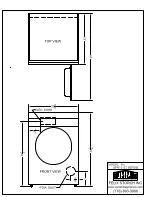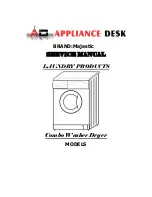
3
Installation
Remove all packaging before positioning the machine.
Any electrical and plumbing work required to install this appliance should be carried out by a qualified
electrician and plumber or competent person.
If possible, position the machine next to a water tap and a drain.
Levelling
Good levelling is essential for correct closure and sealing of the door.
When the appliance is correctly levelled, the door will not catch on the levelling
spacers on either side of the cabinet.
If the door does not close correctly, loosen or tighten the adjustable feet until the
machine is perfectly level.
Fitting under a counter
(kitchen worktop or sink)
By removing the machine’s worktop, you can install it
under a close fitting sink unit or a pre-existing top,
providing the dimensions of the recess correspond to
those shown in the figure.
Proceed as follows:
Remove the machine’s worktop by unscrewing the two
rear retaining screws, pull from the front and slide out the
rear slots, lifting the worktop.
Insert the machine after adjusting height and levelling with the adjustable feet.
When inserting the machine, ensure that the water inlet and drain hoses are not kinked or squashed.
Water supply connections
This dishwasher must be plumbed into a cold water supply.
The water pressure must be within the limits given in the technical specifications.
Your local Water Authority will advise you on the average mains pressure in your area.
The dishwasher features fill and drain hoses which can be turned either to the left or the right to suit the installation.
The locknut must be correctly fitted to avoid water leaks.
Avoid bends or kinks in the hose which could prevent or slow down the water supply.
Water outlet hose connection
Ensure the hose is not bent or squashed as this could prevent or slow down the discharge of water.
If you use a drain hose extension it must be no longer than 2 metres. The drain hose can be connected in the
following ways:
Electrical connection
Before plugging the appliance into the wall socket, make sure that:
1. The mains voltage corresponds to the voltage given in the "Technical specifications".
2. The meter, fuses, mains power supply and wall socket can all take the maximum load required.
Make sure that the socket and plug are compatible without having to use any type of adaptor. If necessary,
have the domestic wiring system socket replaced.
Attention! Safety standards require the appliance to be earthed.
The manufacture accepts no liability for failure to observe the above safety precautions.
min 30 cm
max 100 cm
min 4 cm
Ø 21
Ø 18
CS17
2
3
1
max 100 cm
min 30 cm
max 100 cm
max 100 cm
+ 2 m max
CS10
Ø 18
Ø 21
IN26
820
570 - 600
600
IN05


























